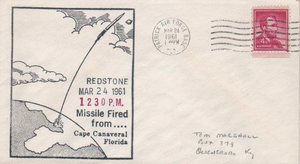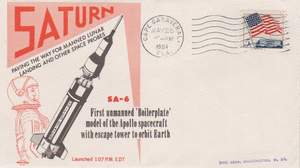Space Cover #228: Boilerplate mail A boilerplate is a space capsule the same size, weight, and shape as the real thing but devoid of all the complex, expensive and delicate innards. It is used to qualify parachutes, floatation devices, recovery hoists and the crews that use them. The astronauts practice egress at sea and recovery personnel become proficient stabilizing, wrangling, and recovering spacecraft bobbing in the open ocean.

The NASA Motor Vessel (MV) Retriever was a Landing Craft Utility (LCU) built for the U.S. Army in 1953. LCU-15301 was acquired from the Army in 1963. After modifications (the sides of the vessel's midsection were cut down, a new bridge built, and a hoist added), it arrived at its Seabrook, Texas docking facility near the NASA Manned Spacecraft Center (MSC) in June 1963. The modified Army LCU, painted NASA blue and white, was named “Retriever” to signify its mission of recovering spacecraft. The LCU was selected because its shallow draft allowed it to operate in Galveston Bay as well as in the Gulf of Mexico off of Galveston, Texas.

Training was not confined to the calm of Galveston Bay and the Gulf of Mexico. The USS Escape conducted exercises off the coast of Virginia. Since there were no postal facilities on board the ship the envelope was postmarked on return to port.

As Project Gemini was preparing to conduct the first launch the USS Wallace L. Lind, a destroyer that would later participate in the Gemini XI mission, used the newly installed crane to practice lifting a Gemini boilerplate out of the Atlantic. George Goldey recycled a cachet with a Mercury capsule for the artwork.

















